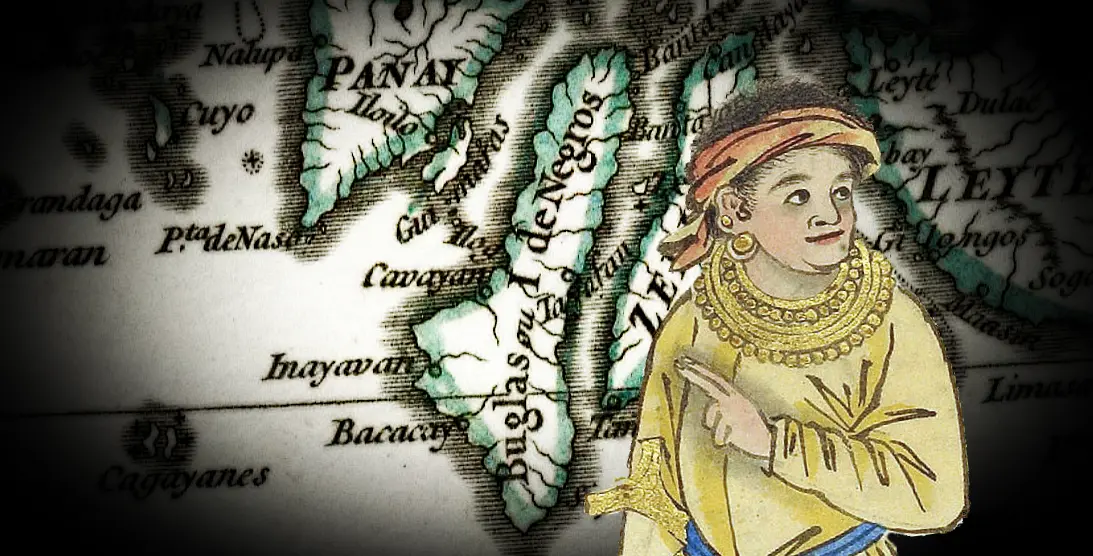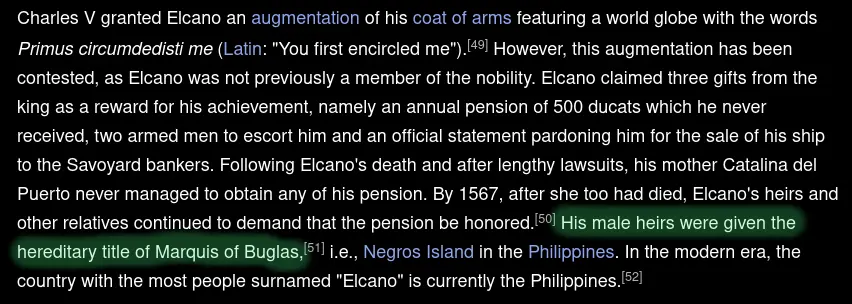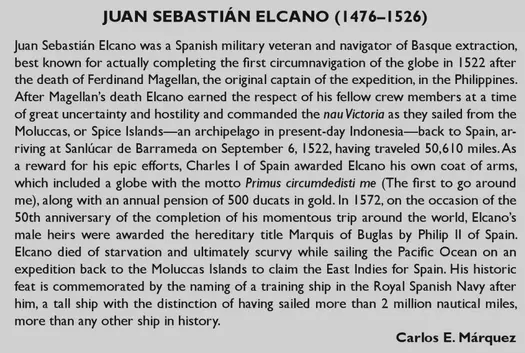
The Mythical Marquis of Buglas

Five centuries ago, on 8 September 1522, a rugged outline of a ship appeared in view from the port of Seville. Urged by the wind and pushed by waves, its faint skeleton, growing clearer by the minute, revealed familiar contours and colours that a few eager onlookers immediately recognised. It was the once glorious and formidable Victoria, one of the five ships under the command of Ferdinand Magellan that sailed out from the same pier to explore the frontiers of western waters. Its battered state bore the scars grossed during the course of its punishing ordeal, but it boldly announced its eternal placement in global history, for having made it back to Spain, the Victoria had just earned the distinction of being the first officially documented ship to completely circumnavigate the world. Behind this grand achievement were the few men who survived the three-year long tribulation and steered the ship back to Spain. As the survivors slowly disembarked and descended on home ground, their gaunt figures, all carved by the cruel craft of erratic fate, disturbed and perturbed the worried witnesses. Cries must have echoed when friends and families were nowhere to be seen, while joyful uproars thundered at the sight of familiar faces.
One of the most notable survivors of the voyage was Juan Sebastián Elcano, the incidental capitan of the ship.
Before he took helm of the Victoria, Elcano was the captain of another boat, the Concepción, awarded to him by virtue of experience and, according to his biographer Cotarelo y Garastazu, “inteligencia é intrepeidéz en los mares de Levante y en las costas de Africa”.1 He was a native of Guetaria, a small coastal community in the Basque region of Spain. Located at the northern edges of the Iberian peninsula, Guetaria was constantly bathed by waves from the Gulf of Biscay, and this proximity with open waters served as the perfect environment for training future mariners. As a young boy surely overwhelmed by the sights, smells, and sensations of a town teeming with maritime activity, it’s easy to imagine Elcano being drawn by the call of adventure early in his life, and indeed, before joining the Magellan expedition he had been part of many other Spanish ventures, for example the conquest of Oran in 1509.
With the backing of experience and commendable maritime aptitude, Elcano must have felt proud at having been selected to lead one of the armada’s ships, but the election of Magellan, a Portuguese, as the fleet’s capitan general stirred in him a simmering distrust. His relationship with Magellan stood on shaky ground even from the beginning. He eventually joined a plot to have the captain ousted, but Magellan acted quickly and decisively, and the mutiny was soon stifled. Elcano and the recreants were immediately apprehended, later to receive punishments and penalties. Despite the gravity of his offense, Elcano was granted amnesty. Magellan only assigned him for heavy and strenuous ship duties.2 The other conspirators weren’t so lucky, as they either ended up executed and their remains thrown overboard or alive but marooned on isolated islands.3
Their tragic yet ultimately triumphant return to Spain punctuated an august event in western history, so Carlos V, then king of Spain and the Holy Roman Empire, quickly seized on their success to exploit it for much needed propaganda. The prestige of having his subjects accomplish the monumental task offered significant economic, scientific, religious, and political advantages over their rivals, especially Portugal, their next door nemesis for naval domination. Central to this feat were the sailors, hence, after a series of summons where they were asked to testify of their experiences of the expedition, the king generously awarded them for successfully returning home with the Victoria. As captain of the ship, Elcano was given a regal coat-of-arms which bore the words “Primus circumdedisti” (“You were the first to circumnavigate me”).4 The king also gave him a hefty prize amounting to five hundred gold crowns.5
But widespread adulation and cheer did not dampen the incessant call of the sea, and soon enough, Elcano enlisted for the next expedition to the Molucas. Unfortunately, even with all the accolades garnered, he wasn’t guaranteed the highest position, and when the king completed his roster of fleet commanders, the overall command went to García Jofre Loaisa instead. On his part, Elcano was to take charge of the second largest ship, the Sancti Spiritus. But bittersweet luck would soon descend and bestow on him his rightful encomium, for a year after the fleet left the ports of Spain, he would eventually be promoted as the capitan general. On 30 July 1526, Loaisa succumbed to a fatal disease and never recovered. On his death, they opened a confidential royal decree that declared the promotion of Elcano to capitan general on the occassion of Loaisa’s demise. It was a much deserved appointment, but a short-lived one, because a few days later, on 4 August, Elcano followed his captain to the afterlife.
The story of Elcano’s return to Spain has all the makings of a heroic tale: it percolates with themes of redemption, tragedy, and glory. And as such, throughout the years it has been plastered with extra layers of explanation, exaggeration, and, unfortunately, fabrication that its public version is now often more legendary than history. While most legends have kernels of truth underneath their fantastic facade—offering historians valuable information to a past deficient in hard data—others are of a kind that only serves to dress pure fiction as fact. There is one rumour from the Philippine island of Negros that is a good candidate for the latter. This is how it goes: Elcano’s son was supposedly given the noble title of “Marquis of Buglas” and one of his descendants still resides in the city of Silay.6

This allegation is included in Elcano’s Wikipedia entry (see image above). It surfaces from time to time in social media. There are also blog posts such as this and this that mention the claim. But in most, if not all, posts outside of Wikipedia, there are no citations supplied, so curious and speculative readers have no breadcrumbs to follow to see if it is actually true. It is simply stated, as if it is a fully established and obvious fact.
Where does the Wikipedia citation lead to? Following footnote 51, we find in the References section an article by Carlos Márquez titled “Juan Sebastián Elcano (1476–1526)”, from the book The Spanish Empire: A Historical Encyclopedia. Luckily, the citation contains an online link, and clicking it leads to the said Márquez article, which is found on page 13 of the book (reproduced below):

Márquez says that the title was bequeathed to Elcano’s surviving sons on the “occasion of the 50th anniversary of the completion of the momentous trip around the world” in 1572. This provides us with a year when the supposed distinction was given—the only useful data we could work with to verify the claim.
So, what went on in 1572? By that time Elcano had long been dead. His mother, Catalina del Puerto, had also died after having lived the last remaining years of her life, it is said, in dire straights. Upon receiving word of her son’s demise and her inclusion in his will, where he entrusted his estate to her (see image below), she immediately went to the authorities to demand the sum owed to her son. This was an arduous process which left her receiving only a fraction of the promised amount. Moreover, Fernandez Navarrete, who wrote an exhaustive biography of the captain, says that Elcano’s children most probably died in destitution and obscurity.7

In the 1570s, king of Spain Felipe II was also facing various threats coming from multiple directions which endangered the stability of the kingdom. The Muslim challenge from the Ottomans prompted Spain’s participation in the Battle of Lepanto, which took place on 7 October 1571. West of the Atlantic, English pirates had made a habit of marauding and pillaging Spanish Caribbean holdings. Then came Protestant naval forces from the north, swooping down into the Bay of Biscay, forcing the king to divide his fleet and military personnel.8 It is thus highly unlikely that Felipe II was able to free some time from his busy schedule to award the relatively unknown children of Elcano with such a grand distinction.
More puzzling is the peculiarity of the act. From 1761 to the last years of Spanish rule in the Philippines, the crown had only given the title of marquis once. Don Manuel Alvarez de Estrada was named Marquis of Camarines for his service in the province. There were also five counts and two viscounts named, and none of them came from the Elcano lineage nor was the island of Negros (Buglas) deemed worthy of being a noble domain.9 Furthermore, all those who received such distinctions had two things in common: they lived in the archipelago and served in it. There is no proof that Elcano’s sons did either. Suppose they did. What remarkable service in the colony, other than having Elcano as a father, did they they do for the crown to deserve titles of nobility? For some context, in 1568 Miguel Lopez de Legazpi, who was named governor of the newly established colony, was fending off a Portuguese fleet led by Gonçalo Pereira who demanded their immediate surrender or departure from Cebu. A year later, when the Spaniards moved west to expand their hold of the Visayas, they skipped the island of Negros and chose to settle in Panay instead. In 1570, with the help of Visayan boat-makers and warriors, they launched an expedition up north in the hopes of establishing a base in Luzon. With so many things happening around them, it is improbable that any of Elcano’s children, supposing they were part of Legazpi’s retinue, would have segued from their objectives, disembarked in Negros, and in a short span of time rendered exemplary service there to deserve the title of marquis.
The choice of using the name Buglas is also highly questionable. It is difficult to tell if the Spaniards had known of the name and were able to transmit the information back to Spain for the king to catch wind of it before 1572. Their earliest knowledge of the island came from the survivors of the Magellan expedition, and they knew it by another name: Panilongon.10 Why, then, did the king not grant Elcano’s children with the title Marquis of Panilongon when that was the known name of the island at the time—and additionally, it was the very name of the island their father was familiar with?
With so little historical evidence supporting the claim, one cannot help but wonder if Márquez enjoys privileged access to a store of secret 16th century Spanish royal documents. An enviable position, in all honesty. But if he does not, and he merely copied the story of Elcano’s alleged Visayan descendants from elsewhere (or himself made it up), then the mythical marquis can simply be dismissed as a runaway gossip which sneakily entered the realm of published texts, and from thereon adopted a veneer of—questionable—credibility. Unfortunately, unsubstantiated claims such as this will always find a number of staunch believers because they also serve to lift local esteem: not only did the king grace Elcano’s family with noble distinction, but Negros itself was also certified as an island worthy of nobility. In this scenario, local pride takes precedence over prudence, and history is abandoned for facile dignity. But if supporters of the nonexistent marquis insist on its truthfulness, they need to do two things: first, recover an authentic document, signed by the then king and verified by experts, stating the grant of margrave status to Elcano’s children; and second, have the said Silay resident undergo a genetic test to see if they actually have any biological affinity with Elcano’s living descendants and relations in Spain. Both are, understandably, very demanding to comply, but they are equally necessary to irrefutably prove the existence and, more important, validity of the said marquis. One can easily claim membership in a prestigious bloodline, the difficult part is actually proving it. However, if all that matters is the mere idea that the island was host to nobility, then there is no need to exert much effort, for there were many of such high births who lived in the island. As we all know, aristocrats, bureaucrats, nobles, politicians, and monarchs are nothing but parasites dressed in elegant, extravagant, and expensive clothing. And from the 1850s onward, Negros has always been plagued by such sycophants. The infection reached its zenith during the time of president Ferdinand Marcos, Sr, whose iron rule enabled his fellow bloodsuckers to dry the marrow of Negros sugar farmworkers during the 1970s-80s, leading to widespread deaths, hunger, and malnutrition. A fate arguably much worse than that endured by Elcano and the other survivors. At least they got to go around the world as a consolation, whereas the emaciated Negrenses could only go through endless cycles of hunger and helplessness.
-
“…intelligence and intrepidness in the Levantine seas and the coasts of Africa.” Juan Cotarelo y Garastazu, Biografia de Juan Sebastian de Elcano (Tolosa: Imprenta de la Provincia), 7. ↩︎
-
Harry Kelsey, The First Circumnavigators: Unsung Heroes of the Age of Discovery (New Haven: Yale University Press, 2016), 141. ↩︎
-
Ibid., 22. ↩︎
-
Cotarelo y Garastazu, Biografia, 26. ↩︎
-
Hugh Thomas, Rivers of Gold: The Rise of the Spanish Empire (London: Weidenfeld & Nicolson, 2003), 449. ↩︎
-
Buglas is one of the precolonial names of Negros. ↩︎
-
Martin Fernandez de Navarrete, Historia de Juan Sebastian del Cano (Vitoria: Imp. de los hijos de Manteli, 1872), 180. ↩︎
-
John Elliott, Imperial Spain 1469-1716 (London: Penguin Books, 1963), 232-33. ↩︎
-
Luciano Santiago, “Philippine Titles of the Spanish Nobility (1761-1897), Philippine Quarterly of Culture and Society 19, no. 4 (1991): 281, 284. ↩︎
-
Coleccion de los viajes y descubrimientos que hicieron por mar los españoles desde fines del siglo XV, con varios documentos inéditos concernientes á la historia de la Marina Castellana y de los establecimientos españoles de Indias, ed. Martin Fernandez de Navarrete, vol. 4 (Madrid: Imprenta Nacional, 1837), 67. ↩︎